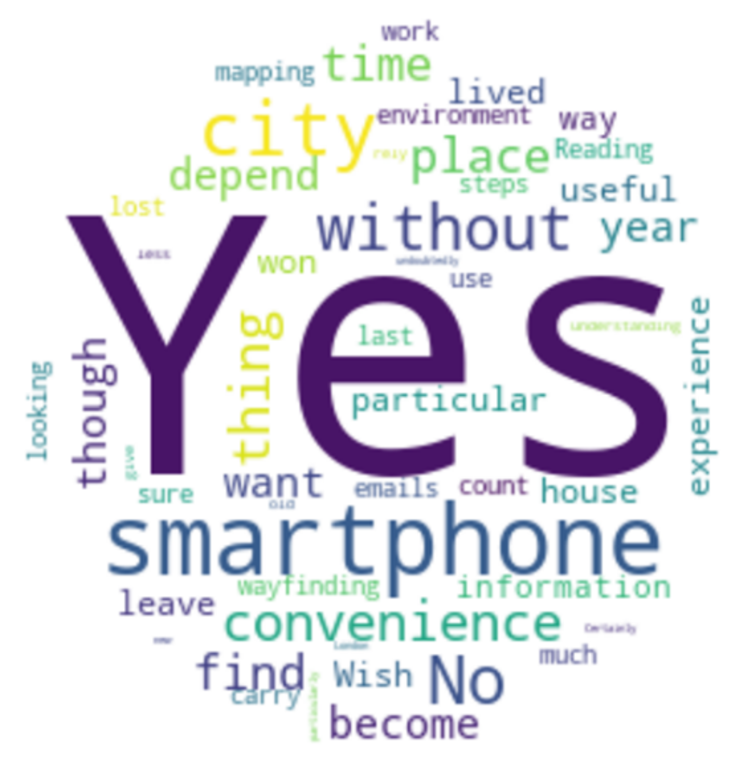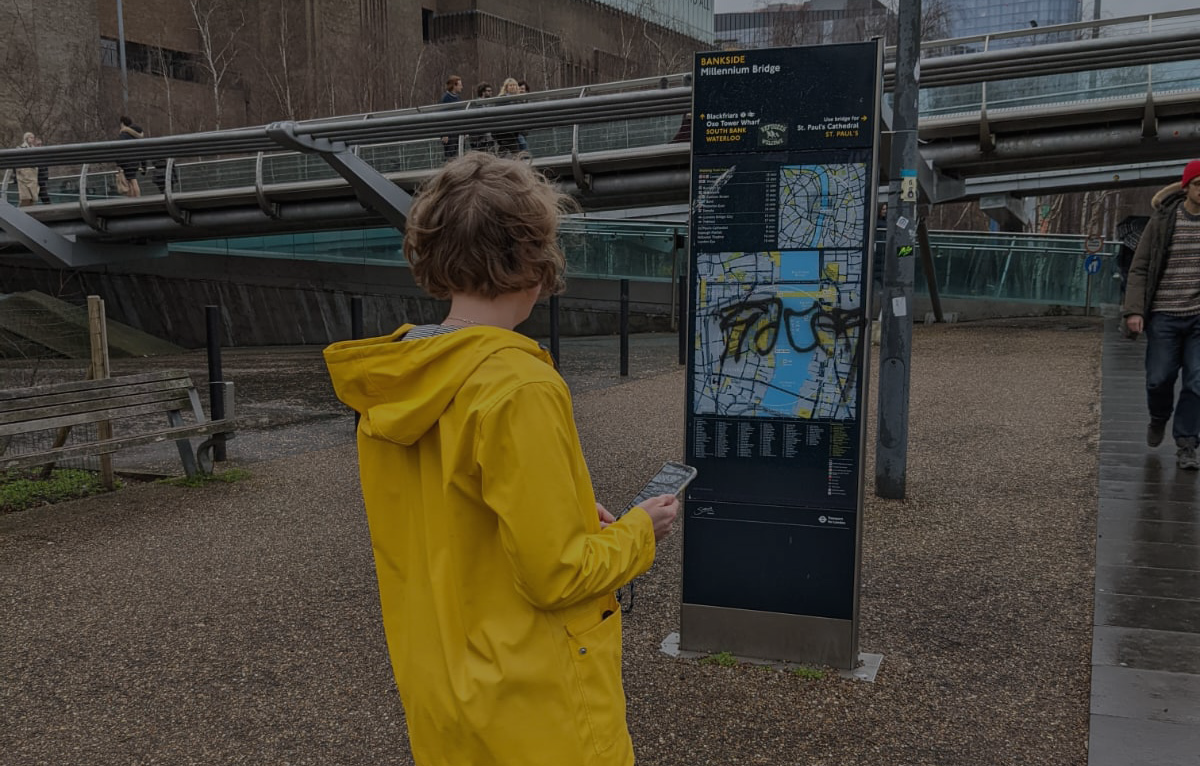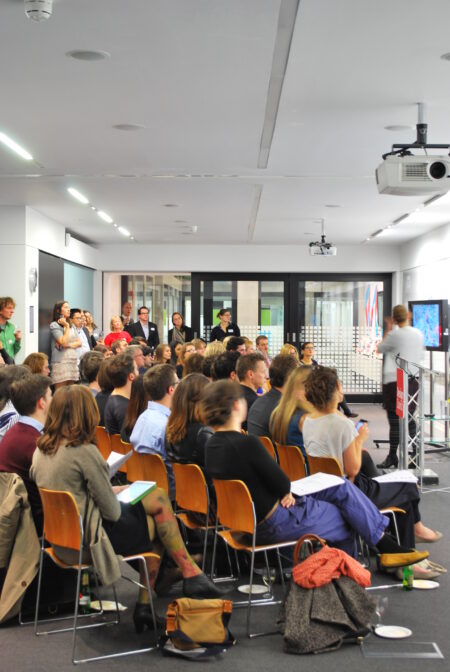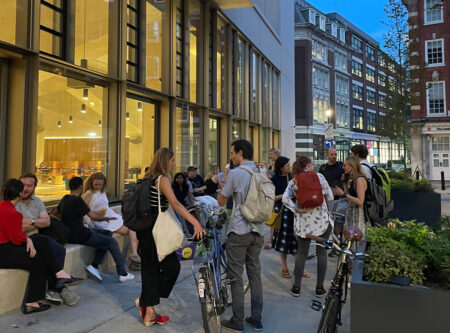As part of the YU Small grant scheme 2021, Cécile Poullain and Pauline Niesseron have explored how smartphones influence our ability to perceive our urban environment, revisiting in the digital age some of Kevin Lynch’s work in his book Image of the City.

 In the last twenty years, we have entered a new era with smartphones invading our lives, affecting our way of connecting with people, navigating the city and perceiving the world. Recent studies show the use of smartphones rapidly increased among all generations in the UK, with 87% of adults owning a smartphone in 2020. Have you ever wondered how you would survive in the city without your smartphone? We asked over 200 people this question through surveys and workshops as part of the 2021 AoU Young Urbanists Small Grant and here is what they said…
In the last twenty years, we have entered a new era with smartphones invading our lives, affecting our way of connecting with people, navigating the city and perceiving the world. Recent studies show the use of smartphones rapidly increased among all generations in the UK, with 87% of adults owning a smartphone in 2020. Have you ever wondered how you would survive in the city without your smartphone? We asked over 200 people this question through surveys and workshops as part of the 2021 AoU Young Urbanists Small Grant and here is what they said…
“Survive, yes. But I choose not to’’ – “Yes, I could “survive” but I would probably feel anxious” – “If the city is accessible and has plenty of landmarks and is laid out in a way that makes navigation easy then yes, I can survive!” – “Yes and no: my phone is my map, my intimate diary and my instant bridge with others.” – “No [I can’t survive without my smartphone] – I have become too dependent on google map, internet banking, last minute meeting and calls, uber…” – “No [I can’t survive without my smartphone] – I wouldn’t be able to carry the equivalent amount of equipment with me.’’
New navigational norms
Today smartphones seem to be an essential in our city kit, with the vast majority of respondents to our survey using their smartphone while outside, primarily for communication, orientation and taking pictures.

Part of this work was to understand how the use of smartphones impacts the way we navigate cities. 61% of respondents said moving across the city was more accessible to them since using a smartphone. Respondents use smartphones to give them live information about the different options available in terms of orientation (94% of respondents use navigation apps to find the best routes to their destination), new transport modes (up to 80% of respondents have already used transport modes available such as Uber, bike or scooter rental), and users experience (60% of respondents use social media, place ratings on Google Maps or similar platforms).
“I keep my eyes wide open for the beauty that is still there. My smartphone will never be in the way for that.”
Quote from a respondent from our march 2021 survey
Most respondents were under 45[1], the age group with the highest rate of smartphone ownership in the UK. Through respondents’ testimonies, we identified new norms in the navigation of cities enabled by smartphone, which we think reflects the emergence of a specific urban lifestyle among younger generations:
- Practice 1: Respondents seek to optimise their trips by using navigation apps helping them to define the most efficient route to reach their destination. Trips seem more purpose driven with some respondents acknowledging there is less space for wandering around. With their smartphone, respondents have the impression of being able to ‘individualise’ their trips based on their travelling preferences.
- Practice 2: Less preparation time is dedicated to planning a trip as smartphones provide live information at any time. This might give respondents the opportunity for more ‘spontaneous’ trips or to easily find alternatives when existing plans have changed.
- Practice 3: Respondents mentioned wanting to ‘optimise’ their experience of a place they are visiting using the online information available on their smartphone to make the most of restaurants, shops or specific things to see.
‘’I’m part of this generation that feel a kind of a vacuum when I don’t have my phone.’’ – “Why should I spend time buying magazines, maps, etc….if all is available within 5min on my phone.” – “No [I can’t survive without my smartphone] if retaining the same lifestyle (i.e. not planning in advance, checking opening hours).’’ – “No [I can’t survive without my smartphone] – functions as an extension of me!”
Understanding our cities
Another part of this work was to understand if the use of smartphones had an impact on our understanding of cities. We found that 84% of respondents consider that ‘smartphones have possibly or definitely helped them to know their city better’. With smartphones, many respondents said the city feels:
- More convenient and accessible to travel – in providing a range of travelling options for people to choose from,
- Safer to explore – through the use of Uber when public transport is not available or in sharing their location when they are going somewhere (especially for women),
- Always within reach – allowing people to experience places more fully in providing more information about these places.
In workshops, participants described smartphones as a companion helping them to come to grips with the city in which they live or visit in helping them find places nearby, check the quickest routes or explore new areas safely with alternatives to public transport. It helps them gain more knowledge about places and feel more familiar as they develop a network of places and people across their city. Through the exercise of mind maps, the majority of participants acknowledged that their personal knowledge of places is now partly informed by the information available on navigation apps and user ratings.

The vast majority of respondents said that yes, they can survive without their smartphone, however a surprising 96% of them acknowledged taking their smartphone when leaving home! There is no straightforward answer and what results from this work is that the smartphone as a navigation tool seems to enhance understanding and improve the practicality of the urban environment for a majority of users. In particular, it plays a role for younger generations in making cities more approachable by enhancing the accessibility, safety and experience of places.
There are some instances in which smartphones seem less needed. Respondents said they were less likely to take their smartphone when in their local area, in nature or when they feel they have good orientation skills. Some respondents mentioned that without a smartphone, it requires them to be more present, use their instinct and forces them to be more connected to people and places. When asked about what they use to guide themselves, 43% of respondents said they equally use both physical landmarks and smartphones. More traditional wayfinding tools such as wayfinding maps or asking people for their way remain important elements to navigation.
Are smartphones becoming the next audio guide to cities?
Exploring cities behind a screen might have consequences in limiting our knowledge of places and reducing our ability to navigate using our own skills and senses. As shown in this work we seem to approach and experience cities differently with a smartphone in hand: we change our habits on how we navigate our urban environment and this affects our understanding and mental image of places.
As urban practitioners, we wonder if cities should be more legible to a larger number of people through the implementation of visual and audio wayfinding, visitor centres or better placemaking for all, which would make smartphones less relevant for orientation purposes. At the same time, given smartphones are here to stay and can be helpful navigational tools, how can cities use them to promote and highlight the specific character of places, providing a wider and non-exclusive knowledge of the cities we live in?
[1] Despite our effort to reach out to different demographics via Linkedin, family, professional and friends networks, AoU etc. 85% of respondents were under 45 years old.






